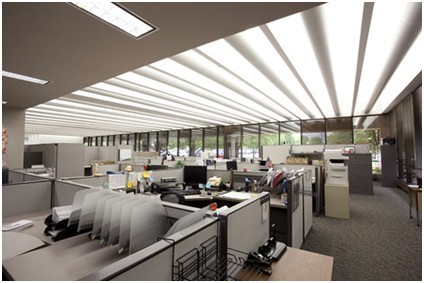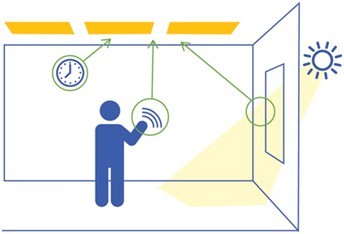The office is a place where employees must feel alert and engaged to be at their best, but often overlooked is lighting—a simple factor influencing not only everyday operations but occupant comfort and the effectiveness with which tasks are completed. GE takes a closer look at six trends driving office lighting best practices today, from dimming down over-lit areas to saving watts in parking lots to setting a more productive mood. As decision makers will see, there are many opportunities to positively impact employee satisfaction and the profitability of their buildings—and businesses—through simple adjustments:

Re-lamping with more efficient linear fluorescent lighting is an easy path to energy savings.
1. Overcome Over-lighting
The Illuminating Engineering Society of North America recommends a 30-50 foot-candle (fc) range for ambient (general) office lighting, yet most workspaces are lit to 60 fc on average. Over-lighting can mean unnecessary eye strain for occupants and higher energy costs for companies. Instead, a layered lighting design offers advantages. A study by the California Lighting Technology Center and the California Energy Commission PIER Program found that utilizing low energy-consumption, LED-based localized task lighting as the primary layer of light in offices resulted in a 50-percent savings in lighting energy usage and overwhelming user satisfaction—evidencing the extent to which a simple lighting design change can make a significant difference.

Most workspaces today are over-lit. To avoid this, it is best to layer different types of lighting in a workspace, such as ambient and task lighting.
2. Retrofit for ROI
Sometimes a simple re-lamping can be a straightforward path to savings. In thousands of office buildings across America, millions of legacy linear fluorescent lighting systems are costing companies uncalculated amounts of energy. What building managers might not realize is that reducing energy use just a few watts per fixture can add up to dramatic savings. For MetLife, a more efficient T8 lamp and ballast system will yield an annual $196,000 cost reduction at its St. Louis administrative center and less interruption to workflow from maintenance on old, energy-draining T12 fixtures.
3. Look Out for Savings
Property owners can also save like Jo-Ann Stores, the nation's largest fabric and craft retailer, which reduced lighting costs in its 777,000 sq. ft. headquarters parking lot by $28,000 a year with outdoor LED lighting fixtures from GE. Advances in LED lighting technology have ushered in a new generation of efficient systems utilizing innovative optics to better “aim” light where it's needed—meaning LED fixtures using 200 watts or less can effectively do the work of traditional 400- and 1,000-watt high-intensity discharge (HID) systems.
4. Take Control
Building managers increasingly rely on smarter lighting control systems to help regulate the use of light. Occupancy sensors, for instance, make it easy to ensure lighting is only 'on' in active areas of a workspace, saving energy. The U.S. General Services Administration recently evaluated the performance of occupant-responsive lighting technology in five federal buildings and realized an annual energy savings of 27 to 63 percent, varying by site. Today, many manufacturers are streamlining building operations as well by integrating their products and systems. This includes GE and Trane, who recently teamed to bring facility professionals a single platform for controlling lighting, heating and cooling that can eliminate the need to monitor multiple systems.

Lighting controls help building managers conserve energy in many ways, such as enabling automatic light level adjustments to changing daylight conditions and occupancy patterns.
5. Give Control
Studies also show that occupants feel more satisfied when given individual control over lighting in their workspace. Allowing employees to adapt their surroundings to their personal preference may seem inconsequential, but it can go a long way to improving mood and inviting collaboration throughout the office. The New York Times Building in midtown Manhattan is a case study in the benefits of task lighting and its potential influence on worker productivity in a cutting-edge work environment.
6. Simplify Your Ceilings
An integrated lighting and ceiling system can distinguish a new building or bring sophistication to outdated office space. This approach adds visual interest to a room by creating channels of light that run the length of the ceiling—the result is an uncluttered, uninterrupted look that can be unlike anything clients or customers have seen before. Tomorrow's ceiling is here today thanks to manufacturers like USG and GE that are designing LED lighting systems to work together.
An office lighting retrofit or redesign can offer a wide range of benefits in many cases, and it does not need to be complicated. Soliciting a professional lighting analysis is a first step to learning more about existing systems and options for improvement. This is also a good time to explore energy-efficient rebate programs that can accelerate your project payback period.





 CN
TW
EN
CN
TW
EN








